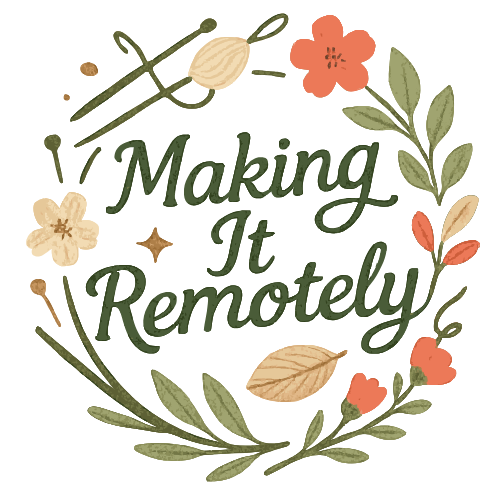In the ever-evolving landscape of education, the concept of work from home has revolutionized the way teachers and course creators engage with their students and learners.
Gone are the days when a traditional classroom was the sole domain for sharing knowledge. As technology continues to reshape the educational sphere, educators and content creators are embracing the virtual realm with enthusiasm and creativity.
Whether you're an experienced educator or a passionate course designer, the opportunities for working from home are endless, offering the chance to inspire and impact learners from across the globe.
Imagine waking up to the warm glow of morning light streaming through your window, knowing that you have the power to shape minds and transform lives—all from the comfort of your own home.
As a teacher or course creator, the freedom of working remotely opens up a world of possibilities, allowing you to break free from the constraints of traditional education and embrace the endless potential of the digital era.
In this article, we'll cover a treasure trove of work from home ideas tailored specifically for educators and course creators, empowering you to chart your path in this exciting new frontier of online learning.
So, if you're ready to fully utilize your teaching abilities and discover innovative ways to share knowledge, read on and unlock the secrets to success in the virtual classroom.
Who This Article is For
This article isn't just for traditional elementary and high school teachers or college professors. This article is for you if you're currently teaching courses in a gym, workshop, meeting room or studio. It's for you if you've never taught but you always wanted to.
The great thing about teaching is that most of us have something we're good at that extends beyond a traditional classroom. Something that others would gladly pay for. And with the internet, it's possible to share your knowledge with a worldwide audience.
When we think of what we're good at, whether it's a hobby that we've enjoyed since childhood, an interest that we've pursued since college or a skill that we learned on the job, It's just a matter of pulling that know how out of our heads, getting it into an online format, organizing it and sharing it with others.
This article will show you how to get started as a remote Teacher, Instructor or Course Creator.
Classroom Teachers
There are remote opportunities for classroom teachers, instructors and course creators that will enable you to share your knowledge to help others learn something new.
For example, a licensed teacher is no longer tied to an in-person classroom. They can apply to work as an employee of a company and teach through prerecorded sessions with organizations like K12 (Stride) and Connections Academy.
Work From Home Ideas for Teachers, Instructors and Course Creators
makingitremotely.com
In Ohio for example, there's a charter school OHDELA that offers opportunities for online instruction. An online search may find that there are similar opportunities in other states across the U.S.
Instructors
Do you know how to play a musical instrument? Can you get people into shape? Are you teaching in person classes at your local recreation center, church or other organization? If so, take your existing courses and put them online for distribution to a global audience.
Start a Money Making WordPress Blog
Create a conversion focused blog that educates, informs, sells and follows up for you 24/7, converting visitors into loyal customers.
Course Creators
The internet has opened a world of opportunities for anyone who wants to share information. Course creation is taking your knowledge from your head or your workshop and sharing it with an audience.
Do your friends and relatives rave about how organized you are? Are you the one that always rallies the troops and plans your family get togethers and vacations? If so, take the knowledge you've gained over the years and turn it into a blog or YouTube channel.
You can also sign up and work on an existing LMS (learning management system) and create paid courses that will showcase your skills and expertise.
If you have a WordPress blog or website, you can also create your own teaching platform with Thrive Suite. Thrive Suite is an all in one sales and marketing tool that enables you to set up conversion focused blogs, landing pages and courses. If you choose this route, you can sign up new students on your blog and work as an independent freelancer.
Industry Information
Even though more schools have returned to in person classes, teachers who can work remotely are still in demand. Whether you’re looking to teach full-time or part-time kindergarten or grad school computer science... or shoe tying, you can share your knowledge and talents by teaching online.
For classroom teachers, pay can vary widely depending on what exactly you teach. According to Glassdoor teachers at K12 (Stride) the typical K12 online teacher salary is $41,637 per year. Online teacher salaries at K12 can range from $34,105 - $60,325 per year.
Here are some interesting statistics from TechJury regarding the e-learning industry:
Corporations
- The worldwide e-learning market is projected to be worth $325 Billion in 2025.
- In 2017, approximately 77% of US corporations used online learning, but 98% planned to incorporate it in their program by 2020.
- The US e-learning market is set to grow by $12.81 billion between 2020 and 2024.
- E-learning increases retention rates by 25% to 60%.
- The corporate e-learning market could increase by $38.09 billion between 2020 and 2024.
- E-learning has lead to an increase in income for 42% of US organizations.
- A survey of 2,500 companies found that those with “comprehensive training programs” have 218% higher revenue per employee and 24% higher profit margins.
- IBM saved approximately $200 million after switching to e-learning.
Schools
Statistics on e-learning in the United States indicate that:
- 63% of high school students in the US use digital learning tools daily.
- 64% of middle schoolers make use of one digital learning tool daily.
- 45% of elementary school students make use of at least one digital learning tool every day.
A good percentage of American graduates (52%) and undergraduates (39%) consider online learning better than classroom learning.
So as you can see, the importance if e-learning in the US is growing. That translates to a growing number of opportunities for online learning in the corporate sector as well as in higher learning.
First Steps to Take Before Creating Your Course
Here are three things you should do before creating an online course:
- The first thing you'll want to do before creating a course is pick a niche. You want to be as specific as possible when picking your niche.
- Then decide who is your ideal customer?
- Finally you want to outline the problem you wan to solve for your ideal customer.
In other words, before investing energy into an online course, you want to know if there an audience or market for what you want to create. Then and only then, will you create your course.
Considerations for Building a Course
As a teacher, instructor or course creator, you can turn your knowledge and teaching expertise into a full fledged business.
You can easily build courses with lessons and resources that can include downloadable documents, workbooks and other materials they need for learning.
You can modules and chapters in video, audio or text format. Combine all of these to create courses on any number of the niche related topics below. Review an ESL demo web page built with teachers and course creators in mind.
Niche Ideas
To get you started, we've created the list below that shows some popular niches for courses. Take a look at the primary niche and the sub-niches. It's important to narrow your focus as much as possible, so choose from the sub-niches when possible.
Keep in mind that the more specific you are, the easier it will be to design a course that fits your niche and ideal customer.
You can create tutorials, workbooks and guides. Teach a full course or a mini course that captures the essence of each topic.
Here are some of the popular niches for creating and selling online courses that could be a perfect fit for those who want to teach online:
Computers and Technology Sub-niches
- Programming for Beginners
- Programming Languages
- Building a Website
- Machine Learning / AI
- Operating systems
- Cyber Security
- Robotics
Business and Entrepreneurship Sub-niches
- Digital (Online) Marketing
- SEO (Search Engine Optimization)
- Affiliate Marketing
- Amazon FBA
- eCcommerce
- Small Business Accounting
- Digital Marketing
- Website Design
- Business Branding
The Arts and Crafts Sub-Niches
- Drawing
- Dancing
- Painting
- Knitting
- Sublimation
- Jewelry Design
- Cricut Crafting
- Digital art
- Photography
- Game design
- Animation
- Illustration
Writing and Content Creation Sub-niches
- Copywriting
- Content Marketing
- Blogging
- Digital Products
- Getting Results with Social Media
- Writing and Book Publishing
- Writing Scripts
- Grammar Review
Health and Wellness Sub-niches
- Diet and Nutrition
- Home Exercises
- Vegan Cooking
- Meditation
- Yoga
- Skin Care
- Soaps and Handmade Creams
- Aromatherapy
Legal Sub-niches
- Logical reasoning
- Children’s psychology
- Languages
- Music
- Investments
- Financial organization
Personal Development Sub-niches
- Time management
- English as a Second Language
- Mindfulness
- Emotional intelligence
- Organization
- Body language
- Leadership
- Persuasion
- Networking
- Negotiation
Career Sub-niches
- How to choose a profession
- Choosing a vocation
- Obtaining an internship
- Written resume
- Job interviews
- Entrepreneurship
- Personal finance
- Life coaching
Entertainment Sub-niches
- Video and Movie Production
- Photo Editing Tools
- Adobe Premiere
- Personal Marketing
- Audience Growth on YouTube
- Live Streaming
- Video Marketing
- Studio Lighting
- How to Create Tutorials
Science Sub-niches
- Physics
- Chemistry
- Biology
- Anatomy and Human Physiology
- Radiofrequency
- Microbiology
- Environmental Sciences
- Pathophysiology
- Genetics
- Thermodynamics
- Climate Dynamics
Once You've Selected a Niche
Once you've selected a niche, it's time to start creating content that people in your niche can use to reach their educational goals.
Start by thinking of the questions people in your niche are asking about niche related topics. Places to find the kinds of questions people are asking are Quora, Facebook Groups, Forums, Discussion Boards and any niche related sites that have frequently asked questions (FAQ) sections.
Use your content to add value. Think of anyone who could use your content, so don't only think of students consider creating content that would help fellow teachers, schools, parents and learners at all ages to resolve issues and solve problems.
Next, Think About Your Platform
A platform is a place that you can use to communicate with your audience. To build a business that you own and control, it's important to have a central hub where you can send people to learn more, have their questions answered and even a place where their objections will be addressed.
There are several places that you can place content, a place that you control or a limited use location. Both places are good for different reasons.
A self hosted blog or eCommerce platform will give you a place to display your courses and products. However that also means that you are responsible for driving traffic and maintenance. Some examples of self hosted sites are WordPress.org and Shopify platforms. In both cases you rent server space from a hosting company, buy your domain and either build your site or have someone build it for you. Once your site is built you can list your products.
A limited use platform is just what it says. You are limited to the kinds of content the owner of the platform allows you to place on their site. Some of these platforms allow you to place a blog on their platform, but you're limited to certain types of content.
Other limited use platforms are marketplaces like Etsy, eBay and Facebook marketplace.
In the next section, we'll talk about the platform we recommend because it's a place that you own and control. For more information on the pros and cons of various platforms read our article on the subject.
A Self Hosted Blog
A self hosted blog is a platform that you own and control, which means you can put whatever you want on... as long as it's legal that is! You can sell content of all kinds, include products you make, products made by others, professional services, virtual services and more.
With a blog you'll never struggle with what to say or where to send potential customers. Your offers and landing pages will generate leads, people who you can talk to about your business.
A blog can help to establish your business as the "go to" place for the best tips, tools, products, services and the best knowledge available in your chosen niche.
A blog, can enable you to focus your content on your chosen niche versus an area of focus handed to you by a boss.
For example, you can sell your own brand of unique, niche specific products, create and sell your own brand of courses, have a flash sale, make the prices up as needed, create sales and landing pages for your offers, recruit, inform, entertain all while earning earn passive income. If you don't have a blog, you can build one by clicking here.
Build Your First WordPress Blog!

We'll show you how to build a self hosted WordPress blog and monetize it to earn from any location.
Build Partnerships with Other Companies
In addition to getting paid each time someone signs up for one of your courses, you can also earn as an affiliate. This is another great reason for having a blog.
Having a platform that you own and control is the ultimate marketing venue.
A blog gives you a platform that you can use to earn as an affiliate and it's attractive to advertisers as well, especially after you have built up your following.
You earn as an affiliate by writing awesome, value added content for people in your niche, or your ideal customer.
Once you've selected a niche and a platform, one of your goals is to build an audience of interested, engaged, loyal followers, leads and customers.
You should optimize your social media profiles so that they drive traffic to your website or platform. And also set up your blog, website or platform so that once someone arrives there it will be easy for them to become a lead or customer.
Once you have an audience of at least 1000 followers, leads or customers, it's time to apply to affiliate programs.
Next, search for affiliate programs and be sure to let the advertisers know that you know how to build an audience. Apply for the ones you're interested in.
An example of a search for affiliate programs would be if you selected the Photo Editing Tools sub-niche, you would go to Google and enter "Photo Editing Tools" + "affiliate programs" into the search bar.
In most cases, you will find lots of affiliate programs that will offer you commissions for sending them new customers. Learn more about affiliate marketing by reading the article, How to Get Started with Affiliate Marketing.
Qualifications
Qualifications vary, depending on the kind of teaching opportunity you’re pursuing. For example, if you’re looking to teach elementary or high school students in an online classroom setting for a local school district, you might need a degree from an accredited college or university.
If you’re someone who teaches a particular skill like music or cooking, you wouldn’t need a degree. You could demonstrate you expertise through live or online demonstrations, tutorials, guides, and the results you've gotten for yourself or your students. If you have certifications or kudos you've received, you can include that information in your bio or "about" section.
If you're an instructor that teaches an in-person course, ask your students for feedback and ideas about what they would like to see in an online course covering your chosen topic. Once you've put together you course, ask them for help spreading the word. You'll be surprised at the power of word of mouth referrals.
Ask them for video and written testimonials you can use to promote your course as well. Show that you know what you're doing with courses that demonstrate your knowledge and skills in a certain area.
Ease of Entry
It depends on the kinds of opportunities you’re pursuing. If you are applying for positions with an online school or university, it's the same as applying online for any job.
If you're interested in creating courses, it's easy to enter the course creation space, but it depends on the time is takes to set up your course, as well as organizing, testing and promoting your courses.
Having a website is a great way to showcase your knowledge, skills and abilities with informative demonstrations, tutorials and courses. It will take time to set up your blog or website and get your courses set up.
Choose Equipment Adapted to the Needs of Teachers and Course Creators

If you're a traditional classroom teacher working with a school, you'll receive training, and equipment to run your classroom that will be provided by your school. If you decide to do some tutoring or online classes as a freelancer, you'll need the equipment and gear discussed below.
You'll need a video camera for demonstrations, tutorials and in person appearances you are planning for your course. Most laptops, tables and smartphones are equipped with great camera and video capabilities that you can use to get started.
A blog would be a great addition to your toolkit because it will enable you to promote your courses, create informative, educational content that will complement your courses.
One of the most important advantages to setting up your own self hosted blogging platform is that you own it and you control it. I talk about this in depth in my article, Why Your Business Needs a Blog.
You might want to sign up with a free or pro Canva account to easily create images of all kinds that you can use in your course(s) and on social media.
You'll also need an office or a quiet place to write, create and edit videos and organize your courses. You'll need a sales and marketing platform
If you have a topic you want to teach, and you're not interested in having your own website, sign up for sites like Fiverr, Coursera, uDemy and other platforms that allow you to teach.
Build your own teaching platform using an all in one marketing toolkit call Thrive Themes that will enable you to build your website, email list, and courses for one flat annual fee. To learn more check it out here.
How to Get Started
To summarize, we've talked about working as a teacher for schools and corporations that hire teachers to work online, we've covered over 80 niche areas of specialty, creating courses, blogging and becoming an affiliate. Each of these areas represent a way to generate income.
It's just a matter of finding an area that interests you! To get started, begin with one of these areas:
- Apply for a job with the companies that work with teachers online.
- Build a blog and start creating content related to one or more of the 80 niche areas we've outlined above. With a blog, you can add an eCommerce store, and earn from the sale of physical products.
- Become an affiliate and generate income from advertisers with lead generation, sales and landing pages that can also be incorporated into your blog.
- Create courses that you sell for a reasonable fee. Promote them to students and organizations who are interested in your topic. Courses can also be sold on your blog.
All of these bullets except the first one, represent opportunities to earn passive income. Working online would get you out of the physical classroom, but it would still require that you physically show up, which is active income.
That means that most of these tasks can be done while you do other things. You can earn extra money while you work a 9 to 5, run errands, relax etc.
Sign up for our newsletter for tips, tools, training and resources that will help you put the pieces together.
For more resources on companies that hire teachers in addition to K12 and Connections Academy, check out this article on Flexjobs.
To build your own self hosted blog, click here. Once you have a blog consider the all in one toolkit that I've talked about in this article. It's the tool I've used to create this website and I've been a user for quite a while. If you have questions contact me and I will be happy to answer them.
Thrive Suite will enable you to build a sales and marketing website that you can use to promote tutoring services and online courses check out Thrive Suite. I’ll also link to a few articles that will help you learn more.
We'll Build a Site for You!
Basic
$
250
This WordPress installation package includes a four page site and gets you off to a great start!
standard
$
350
The WordPress installation package that provides six site pages and two landing pages to highlight your offers!
ecommerce
$
500
This WordPress package includes eight pages, four landing pages and an eCommerce store!
Get Ideas for Your Blog. Contact Us and Let Us Know What You're Looking for.
Subscribe to Our YouTube Channel
We're helping creative business owners go from stuck and confused to empowered and thriving one video at a time.




